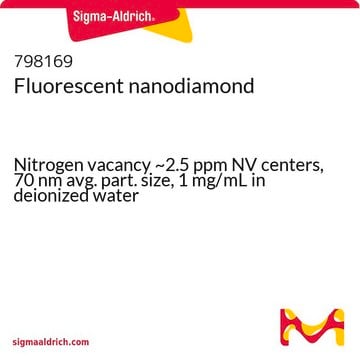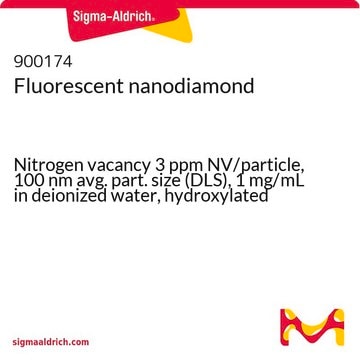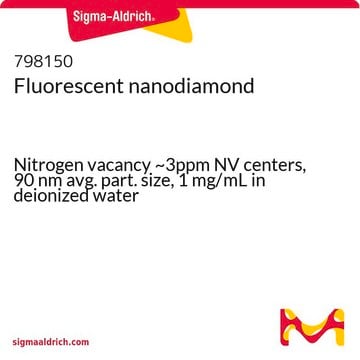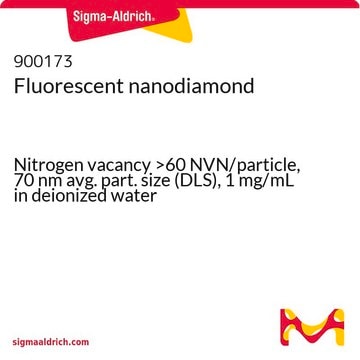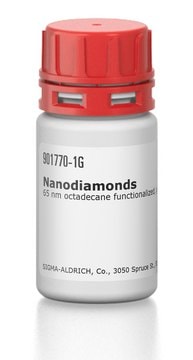Please see the image below to review the spectral data for this product.
798088
Fluorescent nanodiamond
Nitrogen vacancy ~3 ppm NV centers, 120 nm avg. part. size, 1 mg/mL in deionized water
Synonim(y):
Diamond nanopowder, Nanodiamonds
Wybierz wielkość
1810,00 zł
Wybierz wielkość
About This Item
1810,00 zł
Polecane produkty
Formularz
suspension
Poziom jakości
skład
Nitrogen vacancy, ~3 ppm NV centers
stężenie
1 mg/mL in deionized water
śr. rozm. cząst.
120 nm
Szukasz podobnych produktów? Odwiedź Przewodnik dotyczący porównywania produktów
Powiązane kategorie
Opis ogólny
Zastosowanie
Kod klasy składowania
10 - Combustible liquids
Klasa zagrożenia wodnego (WGK)
nwg
Temperatura zapłonu (°F)
Not applicable
Temperatura zapłonu (°C)
Not applicable
Wybierz jedną z najnowszych wersji:
Masz już ten produkt?
Dokumenty związane z niedawno zakupionymi produktami zostały zamieszczone w Bibliotece dokumentów.
Klienci oglądali również te produkty
Produkty
Fluorescent Nanodiamonds and biofunctionalization strategies are detailed for imaging and bioconjugation applications.
Fluorescencyjne cząstki nanodiamentowe (FND) - Poznaj właściwości i zastosowania cząstek nanodiamentowych.
Fluorescent Nanodiamond Particles (FNDs)- Find properties and applications of nanodiamond particles.
Biomaterials science integrates smart materials into biological research, requiring a deep understanding of biological systems.
-
I would like to see the fluorescence response of 798088
1 answer -
1. Is your inflorescence nanodiamond dyed?
2. What are the excitation and emission wavelengths for them? are their quantum yield and brightness information available?
3. What is the function of the PEG functionalization here? Does it reduce surface tension? Does the functional group affect the fluorescent intensity?
4. Has it been used for some fluorescent tracing experiments?1 answer-
1 The fluorescence originates from the nanodiamonds centers, such as nitrogen-vacancy (NV), NVN, or N3, and not from any fluorescent groups. Therefore, it is not dyed.
2 The excitation/emission wavelengths are consistent for these products and are based on the nanodiamonds center. The catalog part numbers, center type, excitation peak, emission peak, and brightness information are as follows:
900173, NVN, 480 nm, 520 nm (green), ~90x vs FITC
All other products, NV, 570 nm, 680 nm (red), ~70x brighter vs Atto 647 Two important notes provided were:
Green fluorescence is brighter than red.
Longer wavelengths, such as red light, have better penetrability.
3 PEG functionalization historically reduces non-specific binding and aggregation in buffered media. Carboxylated particles are commonly used for sensing and imaging applications, or to conduct further syntheses in the lab. However, in biological media/buffer (e.g., PBS), they are prone to aggregation, and surface coatings help to reduce this. Moreover, other functionalizations, such as biotin or antibodies, allow for selective targeting.
4 Threr is information available that it has been used in fluorescent imaging experiments.Helpful?
-
Active Filters
Nasz zespół naukowców ma doświadczenie we wszystkich obszarach badań, w tym w naukach przyrodniczych, materiałoznawstwie, syntezie chemicznej, chromatografii, analityce i wielu innych dziedzinach.
Skontaktuj się z zespołem ds. pomocy technicznej